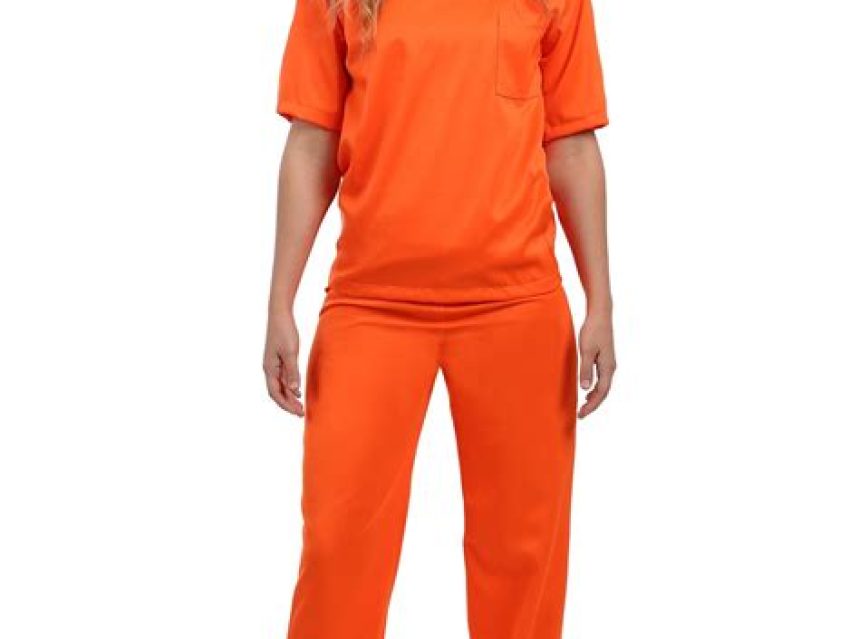Female Prison Uniform

In the world of criminal justice, female prison uniforms have gone through significant transformations over the years. From their humble beginnings to the present day, the evolution of these uniforms tells a compelling story of societal changes and shifting perspectives on incarceration. But what is the purpose behind these uniforms? Why are design considerations crucial in their development? And perhaps most intriguingly, what psychological impact do they have on female prisoners? Join us as we explore the fascinating journey of female prison uniforms, delve into the controversies surrounding them, and uncover the profound implications they hold within the walls of correctional institutions.
Evolution of Female Prison Uniforms
The evolution of female prison uniforms is a fascinating topic that sheds light on the changing attitudes towards incarceration and rehabilitation for women. Over the years, these uniforms have undergone significant transformations, reflecting societal shifts in perceptions of gender, punishment, and rehabilitation.
One of the earliest forms of female prison uniforms can be traced back to the 19th century when women started to be incarcerated separately from men. These uniforms were often simple, modest dresses made from plain and coarse fabric, symbolizing punishment and moral reform. The purpose was to strip away the individual identity of the prisoner and emphasize their role as a convict.
As the 20th century progressed, there was a gradual shift towards a more standardized and practical approach to female prison uniforms. The emphasis began to shift from punishment to rehabilitation, and the design considerations started to take into account the psychological impact on the prisoners. The purpose of these new uniforms was not only to identify the prisoners but also to promote a sense of self-respect and dignity, which would contribute to their rehabilitation.
Design considerations for female prison uniforms today involve balancing security concerns with the need to respect the individuality and cultural backgrounds of the prisoners. These uniforms are typically designed to be durable, easily identifiable, and non-restrictive. The use of colors and symbols may vary, with some institutions opting for bright color schemes to enhance visibility, while others choose more subdued colors to encourage a sense of calmness and stability.
- Uniforms should be comfortable and allow for ease of movement
- Garments should be constructed from durable materials to withstand frequent washing and wear
- Identification, such as unique numbers or insignia, should be incorporated into the design
- Uniforms should comply with safety and security requirements, such as the absence of potential weapons or hiding places
Despite the advancements in the design of female prison uniforms, controversies surrounding them still persist. Some argue that these uniforms further stigmatize and dehumanize female prisoners, while others believe that the uniforms are an essential tool for maintaining order and security within correctional facilities.
In conclusion, the evolution of female prison uniforms mirrors the changing ideologies surrounding incarceration, rehabilitation, and gender. From punitive and restrictive outfits, the focus has shifted towards designing uniforms that balance security concerns with the promotion of self-respect and a sense of individuality. While the controversies surrounding these uniforms continue, ongoing discussions and advancements in design aim to create a system that considers both the psychological impact and the practical needs of female prisoners.
Purpose of Female Prison Uniforms
The purpose of female prison uniforms is to maintain order and security within the correctional system. These uniforms serve several important functions in a prison setting, ensuring the safety of both inmates and staff. The design and implementation of female prison uniforms are guided by various considerations, such as the need for identification, control, and deterrence.
Identification: Female prison uniforms play a vital role in identifying inmates easily and quickly. The distinct color and style of the uniforms make it easier for correctional officers to distinguish between inmates and visitors or staff members. This identification helps in maintaining security within the prison, preventing unauthorized individuals from entering restricted areas.
Control: Prison uniforms also contribute to maintaining control and order within the correctional facility. By requiring all female inmates to wear the same clothing, prisons can establish a sense of uniformity and conformity. This promotes a structured environment and minimizes potential conflicts or attempts to blend into the general population that can disrupt day-to-day operations.
Deterrence: The purpose of female prison uniforms extends beyond identification and control; they also serve as a deterrent. The design of these uniforms often aims to visually differentiate inmates from the general public. This differentiation reminds inmates of their loss of freedom and serves as a reminder of the consequences of their actions. The presence of uniforms can help deter potential criminal behavior both inside and outside the prison walls.
In conclusion, the purpose of female prison uniforms goes beyond mere clothing. It plays a crucial role in maintaining order, ensuring safety, and promoting control within correctional facilities. Through effective identification, control, and deterrence, female prison uniforms contribute to the overall security and stability of the prison system.
Design Considerations for Female Prison Uniforms
When it comes to designing prison uniforms for female inmates, there are several important considerations to keep in mind. These considerations go beyond just the functionality and practicality of the uniforms, but also take into account the unique needs and challenges faced by women in the prison system. Designing uniforms for female prisoners requires a careful balance of maintaining security and control, while also promoting dignity, comfort, and a sense of individuality.
One of the key design considerations for female prison uniforms is ensuring they are suited to the specific needs of women. Women have different body shapes and sizes compared to men, so it is important to create uniforms that fit well and are comfortable. This includes providing various sizes and considering the use of elastic or adjustable components to accommodate different body types. Taking into account the unique physical needs of women, such as menstrual hygiene, is also crucial in designing functional uniforms.
Another important aspect of designing female prison uniforms is considering the psychological impact they have on the wearers. Prison uniforms can be dehumanizing and stigmatizing, so efforts should be made to create designs that promote a sense of dignity and self-worth. This can be done through the use of colors and fabrics that are less institutional and more similar to regular clothing. Allowing for certain personalization options, such as adding small accessories or customizing the fit, can also help to alleviate the negative psychological effects of wearing a uniform.
Psychological Impact of Female Prison Uniforms
Female prison uniforms have long been a subject of interest and debate. Beyond their functional purpose, these garments carry a significant psychological impact on incarcerated women. The design, color, and overall appearance of these uniforms can greatly affect the mental wellbeing and self-esteem of female prisoners. In this blog post, we will explore the psychological impact of female prison uniforms and delve into the various factors that contribute to their influence.
1. Self-Perception and Identity: One of the major psychological impacts of female prison uniforms is the effect on self-perception and identity. When individuals are stripped of their personal clothing and forced to wear a standardized uniform, it can create a sense of loss of individuality and control. In the case of female prisoners, the uniform may emphasize their incarceration status and make them feel dehumanized, further reinforcing negative self-perception.
2. Stigmatization and Labeling: Female prison uniforms often come with stigmatization and labeling. The clothing can serve as a visual marker of a person’s involvement in the criminal justice system, leading to potential discrimination and social exclusion. This stigmatization can contribute to feelings of shame, guilt, and low self-worth among incarcerated women, making it harder for them to rehabilitate and reintegrate into society upon release.
3. Emotional Wellbeing and Mental Health: The psychological impact of female prison uniforms is closely tied to the emotional wellbeing and mental health of the individuals wearing them. The uniform’s design, material, and fit can influence how comfortable or uncomfortable an incarcerated woman feels. Ill-fitting or overly restrictive uniforms can cause physical discomfort and contribute to emotional distress, potentially exacerbating existing mental health issues and impeding the chances of effective rehabilitation.
It is crucial to recognize that the psychological impact of female prison uniforms extends beyond the physical aspects of the garments. The design considerations, color choices, and overall visibility of these uniforms play a pivotal role in shaping the mental state and overall experience of incarcerated women. Reform-minded approaches are exploring alternative uniform designs that prioritize dignity, rehabilitation, and the preservation of individual identity. By considering the psychological implications, we can work towards creating more humane and supportive environments for incarcerated women, fostering their rehabilitation and eventual successful reintegration into society.
Controversies Surrounding Female Prison Uniforms
Female prison uniforms have long been a subject of controversy and debate. These uniforms, designed specifically for incarcerated women, have faced criticism on multiple fronts. From concerns regarding their purpose and design considerations to the psychological impact they may have on female prisoners, the controversies surrounding female prison uniforms have sparked discussions about the reform of correctional practices.
One of the primary controversies surrounding female prison uniforms is their purpose. While the main intention behind any prison uniform is to establish a standardized dress code for inmates, some argue that female uniforms serve additional purposes. Critics claim that these uniforms are often designed to enforce gender stereotypes and promote a sense of humiliation. The question of whether female prison uniforms should prioritize security and control over preserving the dignity and self-esteem of incarcerated women remains a topic of heated debate.
Design considerations also play a role in the controversies surrounding female prison uniforms. Many argue that these uniforms are not tailored to the specific needs and comfort of women. Ill-fitting garments, limited sizes, and inadequate hygiene provisions often contribute to feelings of discomfort and dissatisfaction among female inmates. The lack of attention given to the design aspect of these uniforms is seen by some as a reflection of a broader disregard for the rights and well-being of incarcerated women.
The psychological impact of female prison uniforms is another contentious issue. Some argue that the uniformity imposed by these uniforms strips individuals of their identity, further diminishing their sense of self-worth. Being dressed alike can create a dehumanizing atmosphere, fostering a feeling of powerlessness and reinforcing the notion of being defined solely by one’s inmate status. It is essential to evaluate the potential psychological consequences of prison uniform policies and explore alternative approaches that empower rather than diminish incarcerated women.
In conclusion, the controversies surrounding female prison uniforms are rooted in concerns about their purpose, design considerations, and psychological impact. Addressing these controversies requires a comprehensive reevaluation of correctional practices, with a focus on promoting dignity, identity preservation, and the overall well-being of incarcerated women. By considering alternative designs, placing a greater emphasis on comfort and individuality, and acknowledging the psychological effects of uniforms, we can begin to foster a more humane and progressive approach to the correctional system.
Frequently Asked Questions
Evolution of Female Prison Uniforms
Example Question: How have female prison uniforms evolved over time?
Female prison uniforms have evolved significantly over time. In the past, women in prisons wore dresses or skirts, similar to their everyday clothing. However, as prison systems developed, the focus shifted towards standardization and security, leading to the adoption of more practical and uniform-like designs for female inmates.
Purpose of Female Prison Uniforms
Example Question: What is the purpose of female prison uniforms?
The purpose of female prison uniforms is multi-fold. Firstly, they serve as a means of identification, helping prison staff easily distinguish between inmates and visitors. Additionally, uniforms promote a sense of discipline and order within the prison environment. They also help ensure the safety and security of both the inmates and the staff.
Design Considerations for Female Prison Uniforms
Example Question: What factors are taken into consideration when designing female prison uniforms?
When designing female prison uniforms, several factors are considered. These include safety, security, comfort, durability, and standardization. The uniform design should minimize the risk of potential self-harm, hide contraband, and prevent escape attempts. It should also be comfortable to wear for extended periods, and durable enough to withstand frequent washing and wear.
Psychological Impact of Female Prison Uniforms
Example Question: What psychological impact do female prison uniforms have on inmates?
Female prison uniforms can have various psychological impacts on inmates. They can create a sense of shame or humiliation, as they serve as a visible reminder of their incarceration. However, some inmates may also find solace in the uniform, as it provides a sense of identity and belonging within the prison community.
Controversies Surrounding Female Prison Uniforms
Example Question: What controversies surround the use of female prison uniforms?
The use of female prison uniforms has sparked several controversies. Some argue that uniforms strip away individuality and self-expression, treating inmates as a homogeneous group. Others argue that the design and color of the uniform can perpetuate stereotypes and stigmatization. Additionally, there are debates regarding the appropriateness of using prison labor to produce these uniforms.



